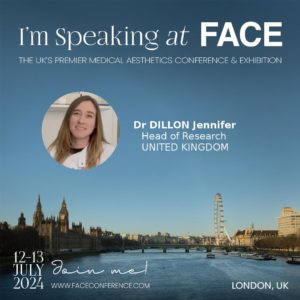In July 2024, the Facial Aesthetics Conference and Exhibition (FACE) congress is heading to London for two consecutive days. It is set to bring 2,000+ medical professionals and aesthetics practitioners together who will hear from over 150 national and international speakers. Delegates can expect a scientific and expert-led programme on the latest advancements in hair and regenerative medicine.
 On Saturday 13th July 2024, HairClone’s Head of Research, Dr Jennifer Dillon will be giving a talk entitled ‘Cloning – the Ultimate Regenerative Treatment’. This is scheduled to take place within the Regenerative Medicine for Hair Loss section of the programme, chaired by scientific committee member Greg Williams. This presentation will explore the history and difficulties of cloning new hairs for clinical application. Dr Dillon will also highlight the shift towards cloning cells as a clinically achievable approach to treat hair loss in men and women.
On Saturday 13th July 2024, HairClone’s Head of Research, Dr Jennifer Dillon will be giving a talk entitled ‘Cloning – the Ultimate Regenerative Treatment’. This is scheduled to take place within the Regenerative Medicine for Hair Loss section of the programme, chaired by scientific committee member Greg Williams. This presentation will explore the history and difficulties of cloning new hairs for clinical application. Dr Dillon will also highlight the shift towards cloning cells as a clinically achievable approach to treat hair loss in men and women.
HairClone is currently working on bringing a personalised cell therapy for treating androgenetic alopecia (pattern hair loss) into the clinic. Through HairClone’s Hair Follicle Banking Service, and in collaboration with clinics, patients can cryopreserve their hair follicles extracted through a minimally invasive surgical procedure. The stem-like cells within the follicle, known as dermal papilla cells, control hair growth and have many future uses in regenerative medicine. Such therapies include HairClone’s cell therapy under development where dermal papilla cells can be multiplied in culture for injection into the scalp with the aim of rejuvenating thinning hair.
For a chance to hear Dr Dillon’s talk in-person as well as other enriching discussions on recent developments in the field of aesthetics, hair and regenerative medicine, you can register to attend on the FACE Conference website. The meeting is organised under the scientific supervision of the Aesthetic Multispecialty Society. This organisation strives to provide and advocate for the continuing education in aesthetics and anti-ageing medicine to improve best practices. The society has a 32-member scientific committee and a community of 20,000+ members, allowing them to connect and network through their bespoke digital platform.
